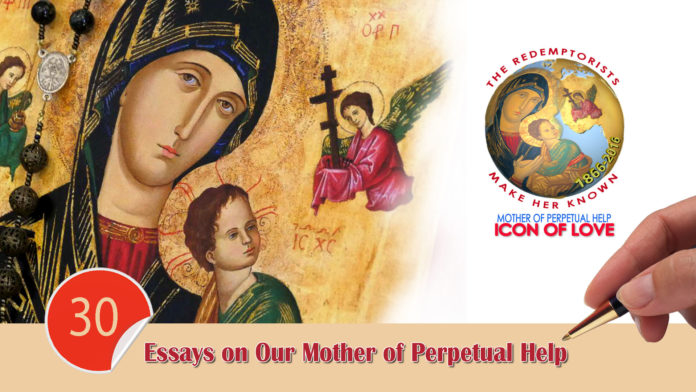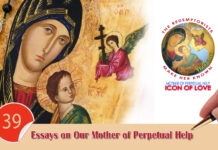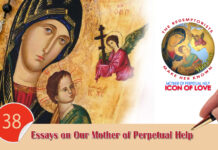One of the first parish missions I led was also one of the most challenging. A teenage girl had been murdered in rural fishing community of 250 people on the northeast coast of Newfoundland, in Canada. Of those 250 people, about one third were related to the victim, another third were related to the murderer, and the rest were related to both. It took a long time for the initial shock to wear off. By then, the grief counsellors had long returned home, and the TV reporters had left to pursue other stories. The parish priest felt ill-equipped to deal with the continuing pain, confusion of his little flock. The community was confused, divided and despairing. In desperation, the pastor asked a Redemptorist team to come and preach a mission in hopes of bringing about healing and reconciliation.
We arrived about 14 months after the murder. The old wooden church, clinging to the cliff overlooking the ocean, had seen better days. It was accessed by a steep, winding staircase of dubious strength. The floorboards creaked as we walked in and waited for the people to arrive. As we looked down the main aisle, the ripples in the floor reminded us of the ripples on the ocean. Its state of disrepair mirrored that of the community. As we decorated the sanctuary with the eight-foot-tall lighthouse that we had chosen as the central symbol of the mission, we wondered whether anyone would come to hear of Good News, and we waited with very real doubt. But arrive they did, silently and stoically, and began to fill up the pews. There was no happy greeting of friends, no hugs or handshakes, no choir to lead the song. The only sound was the heavy tramping of tired feet as people filed into their usual places—the victim’s family on one side of the church, the perpetrator’s family on the other side, and, huddled at the back, near the door, those who were related to both. Some of the eyes that fixed on us were pleading, others were challenging, even daring, some eyes were filled with pain and discouragement, and many still struggled to hold back tears.
I breathed a silent prayer to the Holy Spirit, as I often do before preaching or leading a gathering. I am a lay woman, and a catechist by vocation. Preaching is not my usual role. I am much more comfortable teaching or leading faith-sharing sessions. But it had fallen to me to preach on this first night of the mission, and so I prayed, “Holy Spirit, please let God’s word be spoken and God’s word be heard in this place tonight.”
I had decided to preach about the Paschal Mystery, hoping that this broken community could see themselves in Christ’s body broken on the cross, find some hope for themselves in His Resurrection, and find strength in Christ’s promise that He would send us a new Spirit to animate the new life that Christ most certainly had in mind for them. And so I began to tell the story of the Redeemer, our nearest blood relative, who gave His life for us, suffered, died and rose for us, and sends His Spirit to sustain us in good times and in bad. I preached with every bit of conviction I could muster. But there was no discernable response. When I had come to the end of the talk, which I had by then determined to have been a failure, I looked out on that sea of tired, sad faces. I did the thing that I knew best; I asked them to talk back to me. I asked them if they could hear echoes of their story, their community’s story, in the story of our Redeemer.
It seemed an eternity before an elderly woman on “her” side of the church– the side where the family of the victim sat– spoke loudly and bitterly. “That’s easy for you to say, but Jesus just died on that cross. My granddaughter was murdered. And there is nobody in heaven or on earth who knows what I’m going through. ” I listened to the pain and torment of the grandmother whose cherished girl, and all the hope that she represented, had been robbed from her.
For a minute, her pain was so intense and real that I almost believed that what she said was true. But, although her experience was real, and her grief was immense, she had missed a very important element of the story. I suddenly knew the words that needed to be spoken. I looked intently at this lady, called her by name and said, “But Jesus didn’t just die on the cross. He was killed. He was murdered.” Her whole body reacted. She turned to face me, stood up in her pew, and said, “Say that again.” I repeated the words, “Jesus didn’t just die on the cross. He was killed.” But this time, I pointed to an old and battered icon of Our Mother of Perpetual Help that hung on the wall of the church and said, “And His mother watched it happen. She was there to see it all.”
The old lady’s face crumbled and she began to cry. “What?” she asked, and she, too, pointed this time to the icon of Our Mother of Perpetual Help. “Do you mean that I could have been talking to Mary all along, and she would have understood?”
The floodgates had opened, and the community began to talk and to talk to one another, finally seeing in their story of pain and anguish the story of the followers of Jesus at the foot of the Cross. Over the next days, they also began to see how, as individuals and as a community, they were being led through suffering to renewal, from death to life, from pain to hope.
Seeing the power that the mention of Mary’s name and her identification with them in their sorrow had, we focused on the icon of Our Mother of Perpetual Help from then on, using the icon as a window or a doorway, connecting their story with the story of redemption. For the rest of that week, we reflected together on their experience in light of the experience of the early followers of Christ, and spoke lovingly of the Mother of God. We told the story of how she stood with the women at the foot of the cross, how she waited with the disciples through the days of darkness and fear, how she witnessed with them the bestowing of the gift of the Holy Spirit and how she also participated with them in the dawn of the missionary Church.
One of the most powerful experiences for me occurred when, on the morning of the second day, a group of mothers came to visit us at the church, where we were gathered, praying and preparing for the evening mission session. Their request was simple, and very moving, “Could you do with our children what you are doing for us adults? They have been hurt, too, and we do not know how to help them.” How could we refuse? And so, from that second night onwards, we gathered with the children at 5:00 p.m. each evening, speaking of friendship with Jesus and one another, of healing and reconciliation and building community. Then, at 7:00 p.m., we would gather with the adults, often using the children’s reflections as the starting point of the adult mission session. The icon of Our Mother of Perpetual Help was a constant reference point.
At the end of that week, our little mission band left a community that was not yet fully healed, but on its way toward the joyful reception of a new Spirit for their new life. On the last night of the mission, the people offered a gift to us and to each other—they presented a community concert, a feat that had been impossible for them in the depths of their sorrow. This offering of song, story and joy was a powerful sign of renewal and healing, and it seemed to us to be an indication that these people were finding their new Spirit for the new life that God was offering to them!
A year later, we were invited back, this time to celebrate with this renewed Christian community the dedication of their new house of worship. We brought with us a gift—a newly-written icon of Our Mother of Perpetual Help. They understood the significance of this gesture and of this gift, as she most certainly understood and celebrated with them in the Kingdom. It still holds a special place in the life of that community and in their place of worship.
In my reflection on this experience, I have come to understand that the stance of Mary in the icon of Perpetual Help is truly the stance of the catechist and, of the mission preacher.
In the icon, Mary looks out at us with a gaze of love and mercy. Her gaze mirrors God’s own gaze, for her mercy and God’s are the same. My role as a catechist is to look with the same gaze of mercy on the people to whom, with whom and among whom I minister. I must meet people where they are. I must acknowledge that there is no place, no life, no situation that I can walk into where God has not preceded me. My job is to make the presence of God explicit, to guide and accompany people as they recognize the Guest who has walked with them all along, and to help people to put their own personal and communal stories in dialogue with the Story of Jesus Christ and His Church.
In the icon, Mary’s eyes are much, much larger than her mouth. She sees much, but says little. In this, there is a wonderful insight for the catechist. I sometimes tend to think that I must teach by words, and my words often fill up too much space, leaving little room for silence. Pope Paul VI keenly observed that modern people listen more readily to witnesses than to teachers and, if they listen to teachers at all, it is most likely because they are first witnesses. The catechist is first a witness. My actions must proclaim the Good News of Jesus Christ. If they do not, the words I speak later will be perceived as empty, meaningless or contradictory.
Though Our Mother of Perpetual Help does not speak, I sometimes think like to think that, if she could speak, her language would be mercy. Mercy is the mother tongue of God, the language that God speaks, and the language taught to Jesus by his mother. In this is another lesson for the catechist, and the mission preacher. My actions must proclaim Christ and the Good News of the Gospel, and the words that follow them must be spoken in the language of mercy. The language of mercy is strong on invitation and call; it abounds in use of words such as come, sit, walk, listen, follow, inherit, and rejoice. The vocabulary of mercy is peppered liberally with words of forgiveness and reconciliation. The language of mercy is expansive and generous. The language of mercy is a missionary language: go, go out, proclaim, heal, love, make disciples, all people, reconcile, baptize, and teach. The language of mercy is also a language of reassurance, “Remember… I am with you always.”
Our Mother of Perpetual Help looks at us, but points to her Son. This is a vital reminder to the catechist, and to the mission preacher. I may be educated, trained and skilled. I may be eloquent and possess the gifts of oratory, but all of this is empty if people are moved to heap praise on me without being moved to offer praise and thanks to the God who is the author of all good gifts. Mirroring Our Mother of Perpetual Help, my job as a catechist is to point people toward Jesus Christ, to assist them on the way, to hold them lovingly for a while, and then to get out of the way as their steps gain strength.
The goal of any catechetical activity is to draw people into an ever-deepening relationship of love with the God who is Father, Son and Spirit. My training and skill must be placed at the service of people, and ought to provide them with the tools, methods and means that might assist them in developing that relationship.
The language of mercy is, I think, the language best suited to drawing people into relationship. Mercy is the loving kindness of God, and our God longs for people, longs to be in relationship with us, and longs to enter into conversation with us. God speaks today with human tongues, and touches with human hands. The language of mercy is sometimes a language of words, but is most often a language of witness and gesture. Thus, the language of mercy, the language of God, is spoken most clearly when, as a catechist, I teach by feeding the hungry, clothing the naked, giving drink to the thirsty, freeing those who are held captive, sheltering the homeless, and visiting the sick.
Most catechists would never see themselves doing these actions, and would sympathize with the people we hear in Matthew 25, who cry, “But Lord, when did I ever see you….?” But we see the Lord in these situations every day. The catechist must be a person who is on the lookout for those occasions when the Lord is to be found.
Today, in my own catechetical ministry, I am not always going about feeding those who are hungry for bread or meat. They are not always thirsty for water. Many of the people to whom I am sent are hungry for words of hope and healing. Some of them are hungry or thirsty for words of challenge. Some thirst for a word of invitation. Most of the people among whom I minister are not naked; they have warm clothing, but they are often stripped bare of their human dignity or of joy by the circumstances of their lives or by workplaces that prize productivity above humanity, or place constant activity or availability as a value above a heathy family life. I sometimes work with people incarcerated in our prison system, but far more often, the people with whom I walk are held captive by poor self-image, lack of self-esteem, or inability to offer or receive forgiveness. I do not often get called up to shelter homeless people under my roof, but I often get called upon to open up the doors of understanding, to unlock doors to minds long closed by misunderstanding or fear, and to lay out before them the richness of the Christian treasury of faith, belief and practice. The language of mercy is a rich and varied language, a language of wide possibility and of supple imagination.
In the icon, Jesus is the size of an infant, but his face and body are those of a much older human. Each step I take into lives is a step onto sacred ground. Although I may work with adults, I am called to cherish and nurture them with the tenderness that a mother would offer to an infant. The face that so many adults present to the world appears to be confident and self-assured, but often masks vulnerability, need and fragility. In the icon, the infant Jesus is depicted as running to his mother in such haste that his sandal has fallen from his foot. This is sacred ground indeed. As a catechist, I am called to foster and build an environment of safety, in which the experiences, the questions, the doubts and the searching of each human heart are welcomed. In this safe and nurturing environment, individuals and groups are most likely to feel welcome to begin to place their own stories in conversation with the great Story of Jesus Christ and his plentiful redemption.
In the icon, Mary stands in the presence of tragedy and death, but she cradles and welcomes the Redeemer, offering him a home in her heart and, at the same time, offering him to the world.
We began this reflection with a story, a story of a community broken and divided by two things: they were divided by a murder and they were further divided by their own inability to forgive, heal and grow. They had faced death, but had lost sight of the One who offers life that transcends death, hope that transcends fear, joy that transcends sorrow. The stance of Mary in the icon of Our Mother of Perpetual Help was a model for them, offering them a window onto healing and reconciliation.
Catechists walk with those who live in the shadow of fear and despair, and we also walk with those who experience the joy of fulfilment and the hope of new beginnings. To all, we propose a relationship with Jesus Christ, and offer a faith perspective that can help people to make meaning of all of life’s events. In light of this, I propose a new vision of the catechist, and of catechetical ministry. The icon of Our Mother of Perpetual Help offers a lens through which the Church might renew its vision of and spirituality for catechetical ministry. elpHelpWith Mary, let us begin to view and describe the catechist as a minister of redemption, an instrument of God’s own perpetual help and a window onto God, speaking the language of mercy to a world and to people in need.
Ann M. Walsh
Lay Missionary associated with the Province of Edmonton-Toronto, Canada







